Military
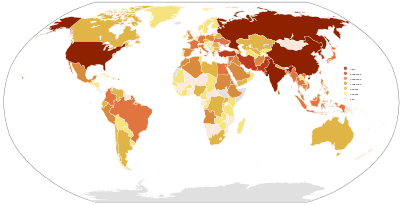
The military, also called the armed forces, are forces authorized to use deadly force, and weapons, to support the interests of the state and some or all of its citizens. The task of the military is usually defined as defense of the state and its citizens, and the prosecution of war against another state. The military may also have additional sanctioned and non-sanctioned functions within a society, including, the promotion of a political agenda, protecting corporate economic interests, internal population control, construction, emergency services, social ceremonies, and guarding important areas. The military can also function as a discrete subculture within a larger civil society, through the development of separate infrastructures, which may include housing, schools, utilities, food production and banking.
The profession of soldiering as part of a military is older than recorded history itself. Some of the most enduring images of the classical antiquity portray the power and feats of its military leaders. The Battle of Kadesh in 1274 BC was one of the defining points of Pharaoh Ramesses II's reign and is celebrated in bas-relief on his monuments. A thousand years later the first emperor of unified China, Qin Shi Huang, was so determined to impress the gods with his military might that he was buried with an army of terracotta soldiers.[1] The Romans were dedicated to military matters, leaving to posterity many treatises and writings as well as a large number of lavishly carved triumphal arches and victory columns.
Etymology and definitions
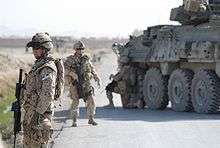
The first recorded use of the word military in English, spelled militarie, was in 1585.[2] It comes from the Latin militaris (from Latin miles meaning "soldier") but is of uncertain etymology, one suggestion being derived from *mil-it- – going in a body or mass.[3][4] The word is now identified as denoting someone that is skilled in use of weapons, or engaged in military service or in warfare.[5][6]
As a noun the military usually refers generally to a country's armed forces or sometimes, more specifically, to the senior officers who command them.[5][6] In general it refers to the physicality of armed forces, their personnel, equipment, and physical area which they occupy.
As an adjective military originally referred only to soldiers and soldiering, but it soon broadened to apply to land forces in general and anything to do with their profession.[2] The names of both the Royal Military Academy (1741) and United States Military Academy (1802) reflect this. However, at about the time of the Napoleonic Wars, "military" began to be used in reference to armed forces as a whole[2] and in the 21st century expressions like "military service", "military intelligence" and "military history" encompass naval, marine and air force aspects. As such, it now connotes any activity performed by armed force personnel.
History
Military history is often considered to be the history of all conflicts, not just the history of the state militaries. It differs somewhat from the history of war with military history focusing on the people and institutions of war-making while the history of war focuses on the evolution of war itself in the face of changing technology, governments, and geography.
Military history has a number of purposes. One main purpose is to learn from past accomplishments and mistakes so as to more effectively wage war in the future. Another is to create a sense of military tradition which is used to create cohesive military forces. Still another may be to learn to prevent wars more effectively. Human knowledge about the military is largely based on both recorded and oral history of military conflicts (war), their participating armies and navies and, more recently, air forces.
There are two types of military history, although almost all texts have elements of both: descriptive history that serves to chronicle conflicts without offering any statements about the causes, nature of conduct, the ending and effects of a conflict; and analytical history that seeks to offer statements about the causes, nature, ending and aftermath of conflicts as a means of deriving knowledge and understanding of conflicts as a whole, and prevent repetition of mistakes in future, to suggest better concepts or methods in employing forces, or to advocate the need for new technology.
Organization
In the whole history of humanity, every nation had different needs for military forces. How these needs are determined forms the basis of their composition, equipment and use of facilities. It also determines what military does in terms of peacetime and wartime activities.
All militaries, whether large or small, are military organizations that have official state and world recognition as such. Organizations with similar features are paramilitary, civil defense, militia or other which are not military. These commonalities of the state's military define them.

Personnel
Subordinated military personnel, generally known as soldiers, sailors, marines, or airmen, are capable of executing the many specialised operational missions and tasks required for the military to execute policy directives.
Just as in the commercial enterprises where there are, in a corporate setting, directors, managers and various staff that carry out the business of the day as part of business operations or undertake business project management, the military also has its routines and projects.
During peacetime, when military personnel are mostly employed in garrisons or permanent military facilities, they mostly conduct administrative tasks, training and education activities, and technology maintenance. Another role of military personnel is to ensure a continuous replacement of departing servicemen and women through military recruitment, and the maintenance of a military reserve.
Command
The first requirement of the military is to establish it as a force with the capability to execute national defence policy. Invariably, although the policy may be created by policy makers or Policy analyst, its implementation requires specific expert knowledge of how the military functions and how it fulfils roles.
The first of these skills is the ability to create a cohesive force capable of acting on policy as and when required, and therefore the first function of the military is to provide military command. One of the roles of military command is to translate policy into concrete missions and tasks, and to express them in terms understood by subordinates, generally called orders.
Military command make effective and efficient military organisation possible through delegation of authority which encompass organisational structures as large as military districts or military zones, and as small as platoons. The command element of the military is often a strong influence on the organisational culture of the forces.
Intelligence
The next requirement comes as a fairly basic need for the military to identify possible threats it may be called upon to face. For this purpose some of the commanding forces and other military, as well as often civilian personnel participate in identification of these threats. This is at once an organization, a system and a process collectively called military intelligence (MI).
The difficulty in using military intelligence concepts and military intelligence methods is in the nature of the secrecy of the information they seek, and the clandestine nature that intelligence operatives work in obtaining what may be plans for a conflict escalation, initiation of combat or an invasion.
An important part of the military intelligence role is the military analysis performed to assess military capability of potential future aggressors, and provide combat modelling that helps to understand factors on which comparison of forces can be made. This helps to quantify and qualify such statements as "China and India maintain the largest armed forces in the World" or that "the U.S. Military is considered to be the world's strongest".[7]

Although some groups engaged in combat, such as militants or resistance movements, refer to themselves using military terminology, notably "Army" or "Front", none have had the structure of a national military to justify the reference, and usually have had to rely on support of outside national militaries. They also use these terms to conceal from the MI their true capabilities, and to impress potential ideological recruits.
Having military intelligence representatives participate in the execution of the national defence policy is important because it becomes the first respondent and commentator on the policy expected strategic goal compared to the realities of identified threats. When the intelligence reporting is compared to the policy, it becomes possible for the national leadership to think about allocating resources over an above the officers and their subordinates military pay and the expense of maintaining military facilities and military support services for them.
Economics


More commonly referred to as defence economics, this is the financial and monetary efforts made to resource and sustain militaries, and to finance military operations including war.
The process of allocating resources is conducted by determining a military budget which is administered by a military finance organisation within the military. Military procurement is then authorised to purchase or contract provision of goods and services to the military, whether in peacetime at a permanent base or in a combat zone from local population.
Capability development
Capability development, which is often referred to as the military "strength", is arguably one of the most complex activities known to humanity because it requires determining: Strategic, operational and tactical capability requirements to counter the identified threats; Strategic, operational and tactical doctrines by which the acquired capabilities will be used; identifying concepts, methods and systems involved in executing the doctrines; creating design specifications for the manufacturers who would produce these in adequate quantity and quality for their use in combat; purchase the concepts, methods and systems; create a forces structure that would use the concepts, methods and systems most effectively and efficiently; integrate these concepts, methods and systems into the force structure by providing military education, training, and practice that preferably resembles combat environment of intended use; create military logistics systems to allow continued and uninterrupted performance of military organisations under combat conditions, including provision of health services to the personnel and maintenance for the equipment; the services to assist recovery of wounded personnel and repair of damaged equipment; and finally post-conflict demobilisation and disposal of war stocks surplus to peacetime requirements.
Development of military doctrine is perhaps the more important of all capability development activities because it determines how military forces were, and are used in conflicts, the concepts and methods used by the command to employ appropriately military skilled, armed and equipped personnel in achievement of the tangible goals and objectives of the war, campaign, battle, engagement, action or a duel.[8] The line between strategy and tactics is not easily blurred, although deciding which is being discussed had sometimes been a matter of personal judgement by some commentators, and military historians. The use of forces at the level of organisation between strategic and tactical is called operational mobility.
Science
Because most of the concepts and methods used by the military, and many of its systems are not found in commercial branches. Much of the material is researched, designed, developed and offered for inclusion in arsenals by military science organisations within the overall structure of the military. Military scientists are therefore found to interact with all Arms and Services of the armed forces, and at all levels of the military hierarchy of command.
Although concerned with research into military psychology, and particularly combat stress and how it affect troop morale, often the bulk of military science activities is directed at military intelligence technology, military communications and improving military capability through research. The design, development and prototyping of weapons, military support equipment, and military technology in general is also an area in which lots of effort is invested – it includes everything from global communication networks and aircraft carriers to paint and food.
Logistics

Possessing military capability is not sufficient if this capability cannot be deployed for, and employed in combat operations. To achieve this, military logistics are used for the logistics management and logistics planning of the forces supply "tail", the consumables and capital equipment of the troops.
Although mostly concerned with the military transport as a means of delivery using different modes of transport from military trucks to container ships operating from permanent military base, it also involves creating field supply dumps in the rear of the combat zone, and even forward supply points in specific unit's Tactical Area of Responsibility.
These supply points are also used to provide military engineering services such as the recovery of defective and derelict vehicles and weapons, maintenance of weapons in the field, the repair and field modification of weapons and equipment, and in peacetime the life-extension programs undertaken to allow continued use of equipment. One of the most important role of logistics is the supply of munitions as a primary type of consumable, their storage and disposal.
Operations
While capability development is about enabling the military to perform its functions and roles in executing the defence policy, how personnel and their equipment are used in engaging the enemy, winning battles, successfully concluding campaigns, and eventually the war, is the responsibility of military operations. Military operations oversees the policy interpretation into military plans, allocation of capability to specific strategic, operational and tactical goals and objectives, change in posture of the armed forces, the interaction of Combat Arms, Combat Support Arms and Combat Support Services during combat operations, defining of military missions and tasks during the conduct of combat, management of military prisoners and military civil affairs, and the military occupation of enemy territory, seizure of captured equipment, and maintenance of civil order in the territory under its responsibility. Throughout the combat operations process, and during the lulls in combat combat military intelligence provides reporting on the status of plan completion and its correlation with desired, expected and achieved satisfaction of policy fulfilment.
Performance assessment
The last requirement of the military is for military performance assessment and learning from it. These two functions are performed by military historians and military theorists who seek to identify failures and success of the armed force and integrate corrections into the military reform with the aim of producing an improved force capable of performing adequately should there be a national defence policy review.
In combat
The primary reason for the existence of the military is to engage in combat, should it be required to do so by the national defence policy, and to win. This represents an organizational goal of any military, and the primary focus for military thought through military history. How victory is achieved, and what shape it assumes is studied by most, if not all, military groups on three levels.
Strategic victory
Military strategy is the management of forces in wars and military campaigns by a commander-in-chief employing large military forces either national and allied as a whole, or the component elements of armies, navies and air forces such as army groups, fleets and large numbers of aircraft. Military strategy is a long-term projection of belligerents' policy with a broad view of outcome implications, including outside the concerns of military command. Military strategy is more concerned with the supply of war and planning, than management of field forces and combat between them. The scope of Strategic military planning can span weeks, but is more often months or even years.[8]

Operational victory
Operational mobility is, within warfare and military doctrine, the level of command which coordinates the minute details of tactics with the overarching goals of strategy. A common synonym is operational art.
The operational level is at a scale bigger than one where line of sight and the time of day are important, and smaller than the strategic level, where production and politics are considerations. Formations are of the operational level if they are able to conduct operations on their own, and are of sufficient size to be directly handled or have a significant impact at the strategic level. This concept was pioneered by the German army prior to and during the Second World War. At this level planning and duration of activities takes from one week to a month, and are executed by Field Armies and Army Corps and their naval and air equivalents.[8]
Tactical victory
Military tactics concerns itself with the methods for engaging and defeating the enemy in direct combat. Military tactics are usually used by units over hours or days, and are focused on the specific, close proximity tasks and objectives of squads, companies, battalions, regiments, brigades and divisions and their naval and air equivalents.[8]
One of the oldest military publications is The Art of War by the Chinese philosopher Sun Tzu.[9] Written in the 6th century BCE, the 13-chapter book is intended as military instruction and not as military theory, but has had a huge influence on Asian military doctrine, and from the late 19th century, on European and United States military planning. It has even been used to formulate business tactics, and can even be applied in social and political areas.
The Classical Greeks and the Romans wrote prolifically on military campaigning. Among the best-known Roman works are Julius Caesar's commentaries on the Gallic Wars and the Roman Civil war – written about 50 BC.
Two major works on tactics come from the late Roman period: Taktike Theoria by Aelianus Tacticus and De Re Militari ("On military matters") by Vegetius. Taktike Theoria examined Greek military tactics, and was most influential in the Byzantine world and during the Golden Age of Islam.
De Re Militari formed the basis of European military tactics until the late 17th century. Perhaps its most enduring maxim is Igitur qui desiderat pacem, praeparet bellum (let he who desires peace prepare for war).
Due to the changing nature of combat with the introduction of artillery in the European Middle Ages, and infantry firearms in the Renaissance, attempts were made to define and identify those strategies, grand tactics and tactics that would produce a victory more often than that achieved by the Romans in praying to the gods before the battle.
Later this became known as military science, and later still would adopt the scientific method approach to the conduct of military operations under the influence of the Industrial Revolution thinking. In his seminal book On War the Prussian Major-General and leading expert on modern military strategy Carl von Clausewitz defined military strategy as "the employment of battles to gain the end of war."[11] According to Clausewitz
strategy forms the plan of the War, and to this end it links together the series of acts which are to lead to the final decision, that is to say, it makes the plans for the separate campaigns and regulates the combats to be fought in each.[12]
Hence, Clausewitz placed political aims above military goals, ensuring civilian control of the military. Military strategy was one of a triumvirate of "arts" or "sciences" that governed the conduct of warfare, the others being: military tactics, the execution of plans and manoeuvring of forces in battle, and maintenance of an army.
The meaning of military tactics has changed over time from the deployment and manoeuvring of entire land armies on the fields of ancient battles, and galley fleets, to modern use of small unit ambushes, encirclements, bombardment attacks, frontal assaults, air assaults, hit-and-run tactics used mainly by guerrilla forces and, in some cases, suicide attacks on land and at sea. Evolution of aerial warfare introduced its own air combat tactics. Often, military deception, in the form of military camouflage or misdirection using decoys, is used to confuse the enemy as a tactic.
A major development in infantry tactics came with the increased use of trench warfare in the 19th and 20th century. This was mainly employed in World War I in the Gallipoli campaign and the Western Front. Trench warfare often turned to a stalemate, only broken by a large loss of life, because in order to attack an enemy entrenchment soldiers had to run through an exposed "no man's land" under heavy fire from an entrenched enemy.
Technology

As with any occupation, since the ancient times the military has been distinguished from other members of the society by their tools, the military weapons and military equipment used in combat. When Stone Age humans first took a sliver of flint to tip the spear, it was the first example of applying technology to improve the weapon.
Since then, the advances made by human societies and that of weapons has been irretrievably linked. Stone weapons gave way to Bronze Age weapons, and later the Iron Age weapons. With each technological change was realised some tangible increase in military capability, such as through greater effectiveness of a sharper edge in defeating leather armour, or improved density of materials used in manufacture of weapons.
On land the first really significant technological advance in warfare was the development of the ranged weapons and notably the sling. The next significant advance came with the domestication of the horses and mastering of equestrianism.
Arguably the greatest invention that affected not just the military, but all society, after adoption of fire, was the wheel, and its use in the construction of the chariot. There were no advances in military technology until, from the mechanical arm action of a slinger, the Greeks, Egyptians, Romans, Persians, Chinese, etc. development the siege engines. The bow was manufactured in increasingly larger and more powerful versions to increase both the weapon range and armour penetration performance. These developed into the powerful composite and/or recurve bows, and crossbows of Ancient China. These proved particularly useful during the rise of cavalry, as horsemen encased in ever-more sophisticated armour came to dominate the battlefield.
Somewhat earlier in medieval China, gunpowder had been invented, and was increasingly used by the military in combat. The use of gunpowder in the early vase-like mortars in Europe, and advanced versions of the long bow and cross bow, which all had armour-piercing arrowheads, that put an end to the dominance of the armoured knight. After the long bow, which required great skill and strength to use, the next most significant technological advance was the musket, which could be used effectively with little training. In time the successors to muskets and cannon, in the form of rifles and artillery, would become core battlefield technology.
As the speed of technological advances accelerated in civilian applications, so too warfare became more industralised. The newly invented machine gun and repeating rifle redefined firepower on the battlefield and, in part, explains the high casualty rates of the American Civil War. The next breakthrough was the conversion of artillery parks from the muzzle loading guns to the quicker loading breech loading guns with recoiling barrel that allowed quicker aimed fire and use of a shield. The widespread introduction of low smoke ("smokeless") propellant powders since the 1880s also allowed for a great improvement of artillery ranges.
The development of breech loading had the greatest effect on naval warfare, for the first time since the Middle Ages altering the way weapons are mounted on warships, and therefore naval tactics, now divorced from the reliance on sails with the invention of the internal combustion. A further advance in military naval technology was the design of the submarine and its weapon, the torpedo.
Main battle tanks and other heavy equipment such as AFVs, Military aircraft and ships are characteristic to organised military forces.
During World War I the need to break the deadlock of trench warfare saw the rapid development of many new technologies, particularly tanks. Military aviation was extensively used, and bombers became decisive in many battles of World War II, which marked the most frantic period of weapons development in history. Many new designs and concepts were used in combat, and all existing technologies of warfare were improved between 1939 and 1945.
During the war significant advances were made in military communications through increased use of radio, military intelligence through use of the radar, and in military medicine through use of penicillin, while in the air the guided missile, jet aircraft and helicopters were seen for the first time. Perhaps the most infamous of all military technologies was the creation of the atomic bomb, although the exact effects of radiation were unknown until the early 1950s. Far greater use of military vehicles had finally eliminated the cavalry from the military force structure.

After World War II, with the onset of the Cold War, the constant technological development of new weapons was institutionalised as participants engaged in a constant arms race in capability development. This constant state of weapons development continues into the present, and remains a constant drain on national resources, which some blame on the military-industrial complex.
The most significant technological developments that influenced combat have been the guided missiles which are used by all Services. More recently, information technology, and its use in surveillance, including space-based reconnaissance systems, have played an increasing role in military operations.
The impact of information warfare that focuses on attacking command communication systems, and military databases has been coupled with the new development in military technology has been the use of robotic systems in intelligence combat, both in hardware and software applications.
Recently, there has also been a particular focus towards the use of renewable fuels for running military vehicles on. Unlike fossil fuels, renewable fuels can be produced in any country, creating a strategic advantage. The US military has already committed itself to have 50% of its energy consumption come from alternative sources.[13]
The MIRV, ICBM and the Tsar Bomb are considered the most destructive weapons invented.
As part of society
For much of military history the armed forces were considered to be for use by the heads of their societies, until recently, the crowned heads of states. In a democracy or other political system run in the public interest, it is a public force.
The relationship between the military and the society it serves is a complicated and ever-evolving one. Much depends on the nature of the society itself and whether it sees the military as important, as for example in time of threat or war, or a burdensome expense typified by defence cuts in time of peace.
One difficult matter in the relation between military and society is control and transparency. In many countries only few information on military operations and budgeting is accessible for the public. However transparency in the military sector is crucial to fight corruption. This showed the Government Defence Anti-corruption Index Transparency International published in 2013.[14]
These relationships are seen from the perspective of political-military relations, the military-industrial complex mentioned above, and the socio-military relationship. The last can be divided between those segments of society that offer support for the military, those who voice opposition to the military, the voluntary and involuntary civilians in the military forces, the populations of civilians in a combat zone, and of course the military's self-perception.
Militaries often function as societies within societies, by having their own military communities, economies, education, medicine and other aspects of a functioning civilian society. Although a "military" is not limited to nations in of itself as many private military companies (or PMC's) can be used or "hired" by organisations and figures as security, escort, or other means of protection where police, agencies, or militaries are absent or not trusted.
Ideology and ethics
Militarist ideology is the society's social attitude of being best served, or being a beneficiary of a government, or guided by concepts embodied in the military culture, doctrine, system, or leaders.
Either because of the cultural memory, national history, or the potentiality of a military threat, the militarist argument asserts that a civilian population is dependent upon, and thereby subservient to the needs and goals of its military for continued independence. Militarism is sometimes contrasted with the concepts of comprehensive national power, soft power and hard power.
Most nations have separate military laws which regulate conduct in war and during peacetime. An early exponent was Hugo Grotius, whose On the Law of War and Peace (1625) had a major impact of the humanitarian approach to warfare development. His theme was echoed by Gustavus Adolphus.
Ethics of warfare have developed since 1945 to create constraints on the military treatment of prisoners and civilians primarily by the Geneva Conventions, but rarely apply to use of the military forces as internal security troops during times of political conflict that results in popular protests and incitement to popular uprising.
International protocols restrict the use, or have even created international bans on weapons, notably weapons of mass destruction. International conventions define what constitutes a war crime and provides for war crimes prosecution. Individual countries also have elaborate codes of military justice, an example being the United States' Uniform Code of Military Justice that can lead to court martial for military personnel found guilty of war crimes.
Military actions are sometimes argued to be justified by furthering a humanitarian cause such as disaster relief operations or in defence of refugees. The term military humanism is used to refer to such actions.
Antimilitarism
Antimilitarism is the society's social attitude opposed to war between states, and in particular countering arguments based on militarism. Following Hegel's exploration of the relationship between history and violence, antimilitarists argue that there are different types of violence, some of which can be said to be legitimate others non-legitimate. Anarcho-syndicalist Georges Sorel advocated the use of violence as a form of direct action, calling it "revolutionary violence", which he opposed in Reflections on Violence (1908) to the violence inherent in class struggle. Sorel thus followed the International Workingmen's Association theorization of propaganda of the deed.
War, as violence, can be distinguished into war between states, and civil war, in which case class struggle is, according to antimilitarists theorists, a primordial component. Hence, Marx's influence on antimilitarist doctrine was not surprising, although making Marx accountable for the antimilitarist tradition is a large overstatement. The belief in the eternal antimilitarist spirit, present in all places and time, is however a myth because the modern military as an institution is a historic achievement formed during the 18th and 19th centuries, as a by-product of the modern nation-states. Napoleon's invention of conscription is a fundamental progress in the organization of state armies. Later, Prussian militarism would be exposed by 19th century social theorists.
Stereotypes
A military brat is a colloquial term for a child with at least one parent who served as an active duty member (vice reserve) in the armed forces. Children of armed forces members may move around to different military bases or international postings, which gives them an unusual childhood. Unlike common usage of the term brat, when it is used in this context, it is not necessarily a derogatory term.
In the media
Soldiers and armies have been prominent in popular culture since the beginnings of recorded history. In addition to the countless images of military leaders in heroic poses from antiquity, they have been an enduring source of inspiration in war literature. Not all of this has been entirely complementary and the military have been lampooned or ridiculed as often as they have been idolised. The classical Greek writer Aristophanes, devoted an entire comedy, Lysistrata, to a strike organised by military wives where they withhold sex from their husbands to prevent them from going to war.
In Medieval Europe, tales of knighthood and chivalry, the officer class of the period, captured the popular imagination. Writers and poets like Taliesin, Chrétien de Troyes and Thomas Malory wrote tales of derring-do featuring Arthur, Guinevere, Lancelot and Galahad. Even in the 21st century, books and films about the Arthurian legend and the Holy Grail continue to appear.
A century or so later, in the hands of writers such as Jean Froissart, Miguel Cervantes and William Shakespeare, the fictional knight Tirant lo Blanch and the real-life condottieri John Hawkwood would be juxtaposed against the fantastical Don Quixote and the carousing Sir John Falstaff. In just one play, Henry V, Shakespeare provides a whole range of military characters, from cool-headed and clear-sighted generals, to captains, and common soldiery.
 Emperor Augustus Caesar in a martial pose (1st century)
Emperor Augustus Caesar in a martial pose (1st century) The Flight of Pompey after Pharsalus, by Jean Fouquet
The Flight of Pompey after Pharsalus, by Jean Fouquet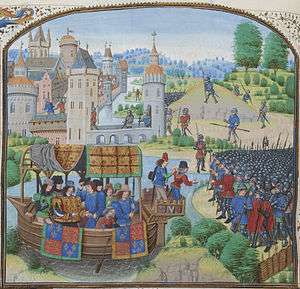 Medieval view: Richard II of England meets rebels
Medieval view: Richard II of England meets rebels- Sir John Hawkwood (fresco in the Duomo, Florence)
 Shakespeare's Sir John Falstaff by Eduard von Grützner
Shakespeare's Sir John Falstaff by Eduard von Grützner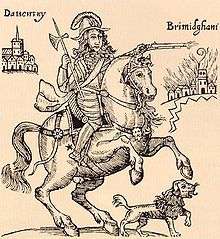 "The Cruel Practices of Prince Rupert" (1643)
"The Cruel Practices of Prince Rupert" (1643)
The rapid growth of movable type in the late 16th century and early 17th century saw an upsurge in private publication. Political pamphlets became popular, often lampooning military leaders for political purposes. A pamphlet directed against Prince Rupert of the Rhine is a typical example. During the 19th century, irreverence towards authority was at its height and for every elegant military gentleman painted by the master-portraitists of the European courts for example, Gainsborough, Goya and Reynolds, there are the sometimes affectionate and sometimes savage caricatures of Rowland and Hogarth.
This continued in the 19th century, with publications like Punch in the British Empire and Le Père Duchesne in France, poking fun at the military establishment. This extended to media other print also. An enduring example is the Major-General's Song from the Gilbert and Sullivan light opera, The Pirates of Penzance, where a senior army officer is satirised for his enormous fund of irrelevant knowledge.
 Colonel John Hayes St. Leger (detail) by Sir Joshua Reynolds
Colonel John Hayes St. Leger (detail) by Sir Joshua Reynolds.jpg) Rowlandson often satirised the military
Rowlandson often satirised the military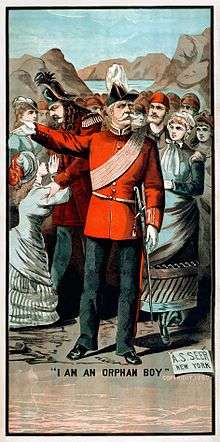 "A modern major general" (The Pirates of Penzance)
"A modern major general" (The Pirates of Penzance)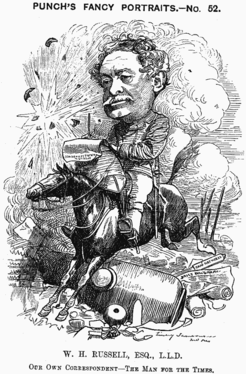
The increasing importance of cinema in the early 20th century provided a new platform for depictions of military subjects. During the First World War, although heavily censored, newsreels enabled those at home to see for themselves a heavily sanitised version of life at the front line. About the same time, both pro-war and anti-war films came to the silver screen. One of the first films on military aviation, Hell's Angels, broke all box office records on its release in 1929. Soon, war films of all types were showing throughout the world, notably those of Charlie Chaplin who actively promoted war bonds and voluntary enlistment.
The First World War was also responsible for a new kind of military depiction, through poetry. Hitherto, poetry had been used mostly to glorify or sanctify war. The Charge of the Light Brigade by Alfred, Lord Tennyson, with its galloping hoofbeat rhythm, is a prime late Victorian example of this, though Rudyard Kipling had written a scathing reply, The Last of the Light Brigade, criticising the poverty in which many Light Brigade veterans found themselves in old age. Instead, the new wave of poetry, from the war poets, was written from the point of view of the disenchanted trench soldier.
Leading war poets included Siegfried Sassoon, Wilfred Owen, John McCrae, Rupert Brooke, Isaac Rosenberg and David Jones. A similar movement occurred in literature, producing a slew of novels on both sides of the Atlantic including notably All Quiet on the Western Front and Johnny Got His Gun. The 1963 English stage musical Oh, What a Lovely War! provided a satirical take on World War I, which was released in a cinematic version directed by Richard Attenborough in 1969.
The propaganda war that accompanied World War II invariably depicted the enemy in unflattering terms. Examples of this exist not only in posters but also in the films of Leni Riefenstahl and Sergei Eisenstein.
Alongside this, World War II also inspired films as varied as Bridge on the River Kwai, The Longest Day, Catch-22, Saving Private Ryan, and The Sea Shall Not Have Them. The next major event, the Korean War inspired a long-running television series M*A*S*H. With the Vietnam War, the tide of balance turned and its films, notably Apocalypse Now, Good Morning, Vietnam, Go Tell the Spartans, Born on the Fourth of July, and We Were Soldiers, have tended to contain critical messages.
There is even a nursery rhyme about war, "The Grand Old Duke of York", ridiculing a general for his inability to command any further than marching his men up and down a hill. The huge number of songs focusing on war include "And the Band Played Waltzing Matilda" and "Universal Soldier".
Masculinity
Masculinity and perceptions of masculinity plays an important role in the military. Military organizations form roles and responsibilities that they expect members to adapt to especially under adverse and life-threatening conditions. Just like it is used within society, masculinity is a word that is associated with the military quite often as gender hierarchy exists in relation to gender subordinated gender constructs.[15] Studies of masculinity within the military have been conducted with British servicemen and it was determined that military forces are masculine institutions and the military culture support this.[16] According to soldiers, toughness, endurance, physical prowess and aggression are requirements to be an effective soldier.[17] Military unit cohesion is created by social rituals which entails almost total subordination to the group and a sense of depersonalization.[15] In addition, military culture is characterized by extremely high levels of social cohesion that is considered essential to the unit's operational efficiency.[15] This masculine emphasis separates rather rigidly the male from the female and puts them in conflict with one another. There have been some attempts of changing this perception late in the 20th century as women in combat have been portrayed in movies like "G.I. Jane" and "Down Periscope".
Masculine emotional control
Military service offers men unique resources for the construction of a masculine identity defined by emotional control, overt heterosexual desire, physical fitness, self-discipline, self-reliance, the willingness to use aggression and physical violence, and risk taking.[18] Emotional control is a very important part of military training and is incorporated into operations. Training exercises are designed to elicit strong emotions that one may face on the battle field. Soldiers are taught to control anger, fear, and grief as to not get in the way of difficult judgments. This type of training creates the 'warrior mindset', but it comes at a cost as it leaves many soldiers without a healthy way to process emotions and events faced by the battle field.[18] Unfortunately, this is believed to be the main cause of the high rate of suicides amongst soldiers.[15] This masculine imperative for emotional self-control places men in a prestigious position and superior to women, since women are believed to be more emotional than men.[19] The presence of women in the military challenges this ideology.
Masculinity in military women
Femininity does have a place within the military, as it does in society, although to a much lesser extent.[20] The increased number of women in the military undeniably signifies a shift in policy. However, current debates focusing on women's contributions to war efforts only serve to consolidate the dominant position of military masculinities within the institution. Focusing on women's difference and women's ability to contribute to strategic military objectives, they fail to challenge the very nature of the armed forces and militarism more widely.[20] Women's role as peace makers and life bearers is thus constructed in opposition to that of the soldier/combatant. Femininity and women are therefore excluded from this essentially male and masculine institution[20]
Though women have long served in the Army and currently make up 15% of U.S. forces in Iraq and Afghanistan and 30% say they served in a combat zone, recent reports attest to their continued marginalization within Army ranks.[21] Women in the military are marginalized because they violate one of the premises of military indoctrination and the myth of an exclusively male-dominated world. As a result of their transgression, not only are women excluded from key aspects of military life, but they are also subjected to violence with great frequency.[21] Recently the pentagon lifted the ban on military women in combat roles.[22]
See also
References
- ↑ Terra cotta of massed ranks of Qin Shi Huang's terra cotta soldiers
- 1 2 3 Oxford English Dictionary (2nd edition) Oxford: 1994
- ↑ Harper, Douglas. "military". Online Etymology Dictionary.
- ↑ Tucker, T.G. (1985) Etymological dictionary of Latin, Ares publishers Inc., Chicago. p. 156
- 1 2 Oxford dictionary
- 1 2 "Merriam Webster Dictionary online". Merriam-webster.com. Retrieved 2011-08-01.
- ↑ Statistics on Americans' opinion about the U.S. being the world's no1 military power, Gallup, March 2012. Retrieved May 3, 2013.
- 1 2 3 4 Dupuy, T.N. (1990) Understanding war: History and Theory of combat, Leo Cooper, London, p. 67
- ↑ "The Art of War". Mypivots.com. 2011-06-11. Retrieved 2011-08-01.
- ↑ "Welcome to the Department of History". westpoint.edu. Retrieved 2011-08-01.
- ↑ MacHenry, Robert (1993). The New Encyclopaedia Britannica. Encyclopaedia Britannica, Incorporated. p. 305.
- ↑ "On War by General Carl von Clausewitz". gutenberg.org. Retrieved 2007-05-31.
- ↑ Craig Hooper. "Ray Mabus greening the military". Nextnavy.com. Retrieved 2012-05-22.
- ↑ Pyman, Mark (March 2013). "Transparency is feasible". dandc.eu.
- 1 2 3 4 Braswell, H; Kushner, H. I. (2012). "Suicide, social integration, and masculinity in the U.S. Military". Social Science & Medicine. 74 (4): 530–6. doi:10.1016/j.socscimed.2010.07.031. PMID 21036443.
- ↑ Gender and the armed forces. research.ncl.ac.uk
- ↑ Green, Gill (2010). "Exploring the Ambiguities of Masculinity in Accounts of Emotional Distress in the Military Among Young Ex-servicemen". Social Science & Medicine. 71: 1480–1488. doi:10.1016/j.socscimed.2010.07.015.
- 1 2 Eisold, K. (2010-06-01). The stoism of soldiers. psychologytoday.com
- ↑ Spade, J.Z. & Valentine, C.G. (2011). The Kaleidoscope of Gender. Pine Forge Press: CA.
- 1 2 3 Guerrina, Roberta. (2012-09-26). Birthing on the front line: A tale of military femininity. e-ir.info
- 1 2 Hynes, Patricia (2012-01-26) Military sexual abuse: A greater menace than combat. truth-out.org
- ↑ Pentagon's Lifting of Combat Ban Comes as Role of Military Women Grows. pewresearch.org. 2013-01-24
External links
- Military Expenditure % of GDP hosted by Lebanese economy forum, extracted from the World Bank public data

